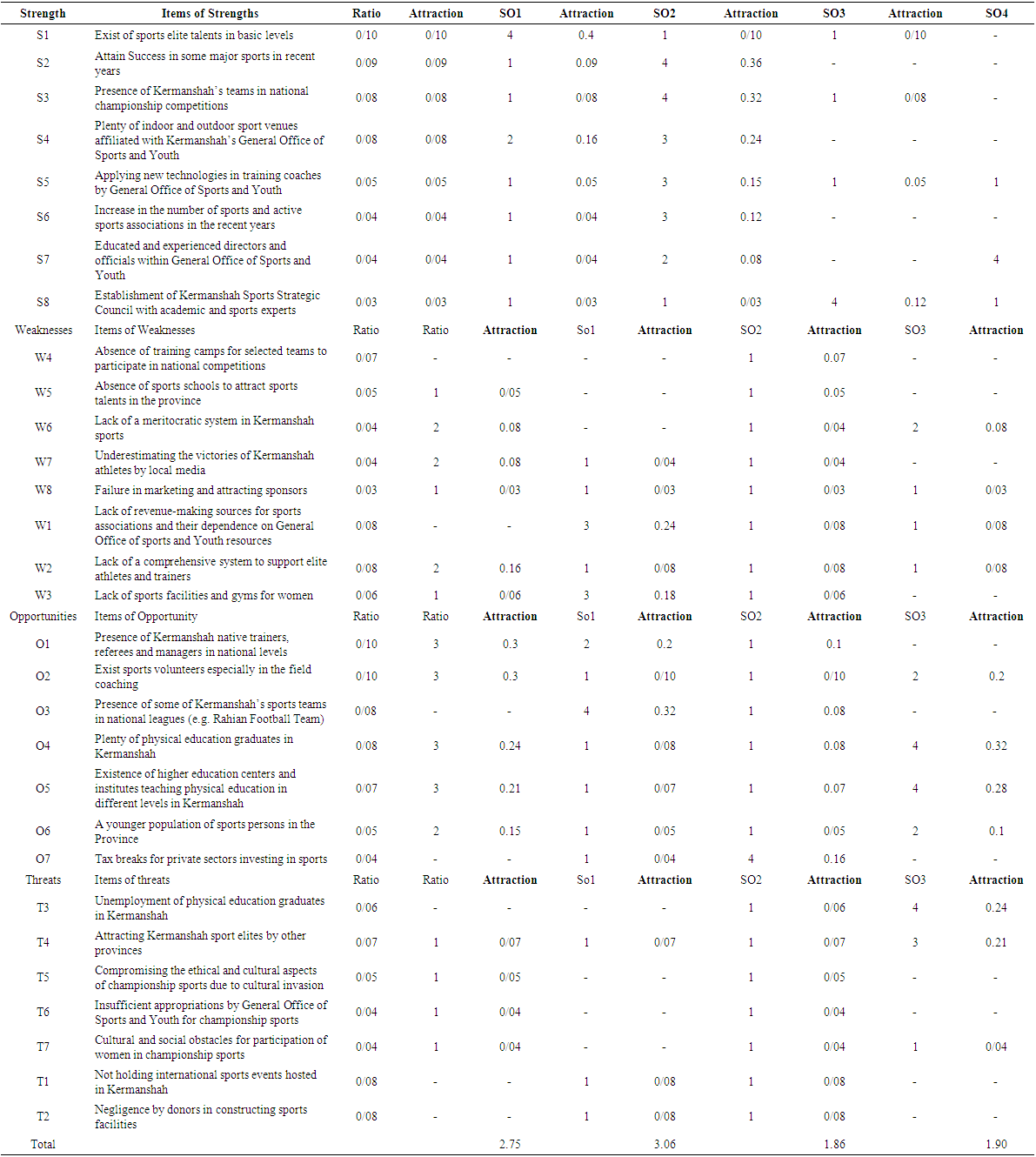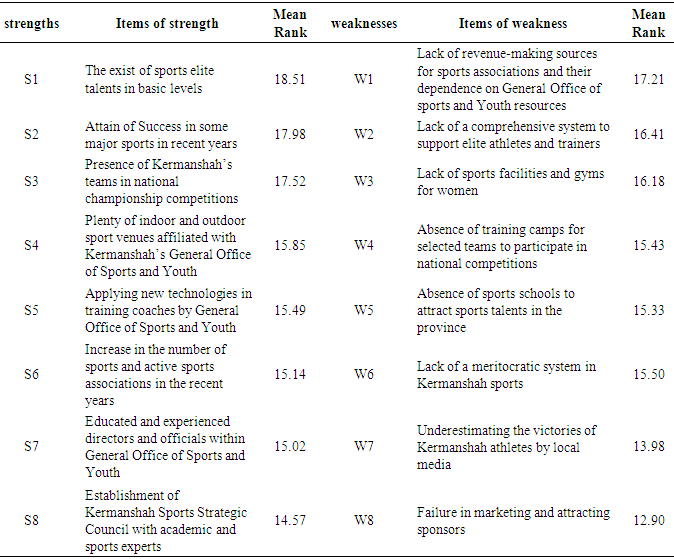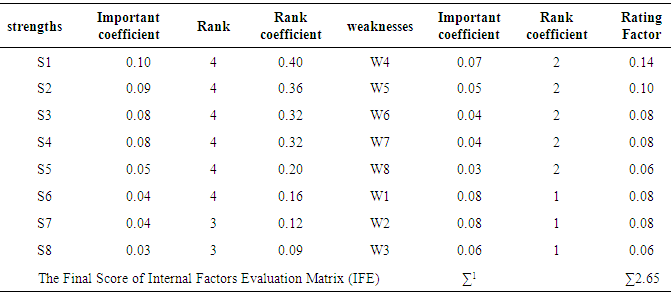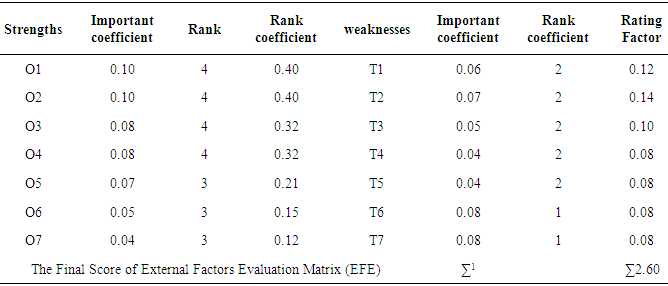-
Paper Information
- Paper Submission
-
Journal Information
- About This Journal
- Editorial Board
- Current Issue
- Archive
- Author Guidelines
- Contact Us
International Journal of Sports Science
p-ISSN: 2169-8759 e-ISSN: 2169-8791
2016; 6(2): 36-45
doi:10.5923/j.sports.20160602.04

Quantitative Strategic Planning of General Office of Sports and Youth in Regard to Championship Sport Using QSPM in Kermanshah
Homayoun Abbasi1, Saeed Khanmoradi1, Hsain Eydi1, Nazanin Rasekh2
1Sport Management Dept. Razi University, Kermanshah, Iran
2Sport Management Dept. Physical Education Research Center, Tehran, Iran
Correspondence to: Homayoun Abbasi, Sport Management Dept. Razi University, Kermanshah, Iran.
| Email: |  |
Copyright © 2016 Scientific & Academic Publishing. All Rights Reserved.
This work is licensed under the Creative Commons Attribution International License (CC BY).
http://creativecommons.org/licenses/by/4.0/

This paper represents the quantitative strategic planning by General Office of Sports and Youth of Kermanshah Province in regard to championship sport using Quantitative Strategic Planning Matrix (QSPM). Research method is descriptive survey which is a part of strategic studies. Statistical population consists of all directors, deputies and staffs of offices of sports and youth as well as chairmen and vice-chairmen of Kermanshah province’s sports associations (186 people). Sampling method used is all-counting and the whole population is considered as sample. 150 individuals answered the SWOT questionnaires designed by the researcher. The questionnaires’ validity was confirmed by sport experts and their reliability was verified by Cronbach alpha (α=0.94). In order to analyse data, descriptive indicators, means comparison and Friedman Test were applied while Internal Factors Evaluation Matrix (IFE), External Factors Evaluation Matrix (EFE), Internal and External Matrix (IE), SWOT and Quantitative Strategic Planning Matrix (QSPM) were used for strategic analysis. Results identified 8 weaknesses, 8 strengths, 7 opportunities and 7 threats for General Office of Sports and Youth regarding championship sport. Strategic situation in SO zone (offensive) was detected and several approaches were presented with determination of relative attractiveness. It is concluded that policy makers in Kermanshah province general office of sports and youth should focus more on advancing championship sport strengths and benefiting from available opportunities and apply the recommended approaches.
Keywords: Championship Sport, Weakness, Strength, Opportunities and Threats, Quantitative Strategic Planning
Cite this paper: Homayoun Abbasi, Saeed Khanmoradi, Hsain Eydi, Nazanin Rasekh, Quantitative Strategic Planning of General Office of Sports and Youth in Regard to Championship Sport Using QSPM in Kermanshah, International Journal of Sports Science, Vol. 6 No. 2, 2016, pp. 36-45. doi: 10.5923/j.sports.20160602.04.
1. Introduction
- Sport pervasiveness and its importance in international events have attracted governments’ attention. Various continental and global competitions, and most notably the Olympics, are the arena for the competition of nations’ chosen youths and this has led to the inclusion of the application of different sciences and arts in sports. Beside social and economic effects, nations’ success in international sports arenas represents stability and comprehensive capabilities and this is one of the reasons countries invest heavily in professional and championship sports. Success in championship sport depends on at least three factors: 1) adequate natural talent, 2) desirable mental condition, and proficiency in technical skills [1]. Given the increasingly significant role sport plays in the economic, social, cultural and even political developments of countries, advancement in sports has become a strategic priority for decision-makers in countries worldwide. Championship sport is one of the aspects of sports that can motivate society members especially the youth. International victory and specifically success in the Olympics have contributed to the development of many countries. Success of the elite athletes in international events grants the nations a special status. Thus, countries tend to lay the ground for the success of their elite athletes in international arenas. This has led to the establishment of organizations and systems dedicated to training elite athletes in championship sports [2]. The money-making aspect of championship sports (due to winning medals and gaining fame and popularity as well as financial rewards for the athletes), attractions of championship sports, publicity and marketing and its advantage in attracting audience have made the government, mass media and the main custodian of sport in the country i.e. Ministry of Sports and Youth pay more attention to championship sports and allocate more budget and publicity to it [3]. Championship sport is one of the main elements of sport development in every country and its development lays the ground for success in international competitions and the Olympics. Competition for medals has increased significantly among countries in the past decades and this has resulted in the countries across the world increasing their championship sport budget. To gain international success, championship sport systems are becoming more and more homogenous and almost all of them follow the same system. Many of these countries have proven that increasing championship sport budget can indeed lead to gaining medals in the Olympics. Still, despite competition and homogeneity of championship sport systems, there does not exist a desirable strategy for success in international level [4]. Results of some studies, however, suggest that capabilities for gaining national and international medals are not equal in various provinces and regions. Therefore, sport experts and researchers seek to identify factors influencing national and regional success in order to pave the way for gaining international and global medal. Nevertheless, several domestic researches have indicated the current performance of Iranian championship sport to be significantly based on periodical and traditional approaches and far from a systematic view in accordance with main factors involved in championship sport [5]. Since the establishment of championship sport in various levels in Iran, the government has financed its costs in different ways. However, this needs fundamental changes in near future. Legislations by the Iranian Parliament prohibiting governmental organizations from financially supporting championship sport is one of the main reasons for such changes. According to these legislations, sports clubs, teams and professional athletes are no longer financially supported by the government and need to gain support from private companies and institutions to survive [6]. SWOT analysis has a broad scope and is considered a conceptual framework for systematic analyses. It allows for the examination and comparison of factors, impasses, threats and harmful aspects as well as opportunities, demands and circumstances of external environment along with internal strengths and weaknesses [7]. SWOT analysis is the science of establishing a method for strategy development. It simplifies complicated issues into managerial tasks and researchers have offered alternative methods and tools using SWOT for strategy analysis [8]. SWOT framework can provide a valuable insight into the competitive position of the company [9]. SWOT analysis is based on the logic that an effective strategy maximizes strengths opportunities and minimizes weaknesses and [10].
 | Figure 1. Comprehensive framework of strategy [11] |
2. Methods
- This paper is a practical research which uses descriptive-survey method to gather data and is considered a part of strategic studies. Statistical population consists of all directors, deputies and experts from the offices of sports and youth as well as chairmen and vice-chairmen of Kermanshah province’s sports associations (186 people). Sampling method used is all-counting and the whole population is considered as sample. Therefore, of 186 questionnaires distributed, 150 correct ones were analysed. Data-gathering tool was SWOT questionnaires designed by the researcher. The questions were compiled based on research principles and through semi-guided interviews with sports management professors as well as sports experts and directors. They included 30 items concerning the strengths, weaknesses, opportunities and threats of Kermanshah’s General Office of Sports and Youth in championship sports. The questionnaires’ validity was confirmed by sport experts and their reliability was evaluated and verified by Cronbach alpha (α=0.94). Descriptive statistics was applied to determine the characteristics of the demographic population while Friedman test was applied to determine the priority of strengths, weaknesses, opportunities and threats in terms of inferential statistics. To calculate the significance coefficient of the internal and external factors, strategic management experts who have a role in mission determination of Kermanshah’s General Office of Sports and Youth regarding championship sports were asked to opine. Also, Internal Factors Evaluation Matrix (IFE), External Factors Evaluation Matrix (EFE) and Internal and External Matrix (IE) were used to determine the strategic situation of the General Office of Sports and Youth regarding championship sports. Several strategies were offered for the fourth zones (strengths, weaknesses, opportunities and threats) using SWOT matrix. Quantitative Strategic Planning Matrix (QSPM) was applied to determine the attractiveness of the strategies.
3. Results
- Descriptive analysis of the subjects: in terms of gender, 54.7 percent male and 45.3 percent female; in terms of age, 14 percent under 30 years old, 58 percent 31-40 years old, 20.7 percent 41-50 years old and 7.3 percent over 50 years old; in terms of organizational position, 5.3 percent deputy, 44 percent expert, 20 percent chairman, 30.7 percent deputy-chairman; in terms of education, 32.7 percent associate degree and less, 40.7 percent BS and 26.7 percent MS and more; and finally in terms of years of service, 0.32 percent less than five years, 35.3 percent 6-10 years, 26 percent 11-15 years and 6.7 percent more than 16 years.Table 1 indicates that the ranking of the strengths, weaknesses, opportunities and threats of Kermanshah’s General Office of Sports and Youth regarding championship sports is significant (P<0.05). This ranking is presented in tables 2 and 3.
|
|
|
|
|
 | Figure 2. IE Matrix of General Office of sports and Youth regarding to Championship Sports in Kermanshah |
|
 | Table 7. Quantitative Strategic Planning Matrix (QSPM) of General Office of Sports and Youth regarding to Championship Sports in Kermanshah |
|
4. Discussion
- This paper aimed to describe the status of General Office of sports and Youth of Kermanshah Province regarding championship sports and to determine its strategic situation. Results indicate that the most important strength of this Office regarding championship sports from the respondents’ perspective is sports elite talents in basic levels. This finding conforms to the results of researches conducted by Rashid Lamir et al (2013) and Saif Panahi Shabani et al (2011) [18, 19]. In regard to the strategic planning of Khorasan Razavi Province’s General Office of Sports and Youth concerning physical education and sports, Rashid Lamir et al (2013) identified the presence of sports talent as the most important strength. In regard to the development of championship sport promotion strategy in Kordestan Province, Saif Panahi Shabani et al (2011) identified talented adolescents in individual and team sports as the most important strength. To interpret this finding, it is notable to say that several sports centers, facilities and venues have been established under the supervision of Kermanshah General office of Sports and Youth across the Province in the recent years and, with the presence of talented trainers, many adolescents and children are attracted to these places and are taking systematic training. Moreover, teens’ and children’s growing interest in sports along with the families’ support and acknowledgment of sports positive influence on their children have brought them to sports facilities and this has led to training elite sport talents in basic levels in Kermanshah Province. Officials at Kermanshah General office of Sports and Youth can utilize this significant resource to promote championship sports by supporting these youths in various ways and granting financial contributions to private sport venues. Results also show that the most important weakness is lack of revenue resources for sports associations and their dependence on Kermanshah General office of Sports and Youth resources which conforms to Rashid Lamir et al (2013). They identified 13 weaknesses in regard to the strategic planning of Khorasan Razavi Province’s General Office of Sports and Youth concerning physical education and sports the most important of which was the office’s dependence on the government and lack of financial independence of sports associations and clubs. To explain this finding, one can say that lack of revenue resources for Kermanshah sports associations and their dependence on the General Office of Sports and Youth resources have caused some problems for championship sports. Sports associations, which don’t have any revenue sources except for that resulting from holding referring and training classes and intra-provincial competitions, are financially dependent on Kermanshah General office of Sports and Youth resources and this prevents sports associations from innovation and creativity. It is thus recommended that Kermanshah General office of Sports and Youth persuade chairmen and vice-chairmen of sports associations to gain revenue by advertisements, attracting sponsors, receiving fees, attracting sports spectators, holding training courses, etc. in order to reduce their dependence on the General Office. Results also suggest that from the respondents’ viewpoint, the greatest opportunity that General Office of sports and Youth of Kermanshah Province regarding championship sports has is the presence of Kermanshah trainers, referees and managers in national levels which can serve as a useful help for sports authorities in Kermanshah who can use their influence in various ways. Finally, findings reveal that the biggest threat that general office of sports and youth of Kermanshah province regarding championship sports faces is the lack of holding international sports events hosted by Kermanshah. This is important because if this threat is changed into an opportunity, and Kermanshah can host national and international competitions, it brings about various advantages including tourist attraction, money-making, popularity of the city, gaining sponsors, etc. therefore, it is recommended that the authorities of General Office of sports and Youth of Kermanshah seek to hold various national and international competitions in the Province by increasing connections and strategic plans in this regard.Eventually, after the evaluation of internal and external factors of General Office of sports and Youth of Kermanshah Province regarding championship sports and given the scores of Internal Factors Evaluation matrix (2.65) and External Factors Evaluation Matrix (2.60), strategic situation of the General Office of sports and Youth of Kermanshah Province regarding championship sports was determined to be at the offensive zone (SO). This finding was inconsistent with those by Ali Abadi et al (2012), Dibaei et al (2014) and Jamshidi et al (2012) while it was consistent with the findings by Ghofrani et al (2009), Nasirzadeh & Vatandoust (2011) and Nazari et al (2014) [20-24]. In the SWOT analysis of Iranian Offices of Sports and Youth, Ali Abadi et al (2012) determined the strategic situation at WO zone. Regarding the strategic planning development of West Azerbaijan Tennis, Dibaei et al (2014) determined the strategic situation at WO zone. Concerning strategy formulation of Iranian Federation, Jamshidi et al (2012) determined the strategic situation at WO zone. In regard to the championship sports development strategy of Sistan and Baluchistan Province, Ghafrani et al (2009) concluded that the General Office of Physical Education of the Province should apply the growth and development strategy for championship sports. Concerning strategy development of Kerman Province’s championship sports, Nasirzadeh & Vatandoust (2011) determined the strategic situation at SO zone. Regarding development and introduction of Strategy Perspectives of General Office of sports and Youth of Isfahan Province regarding championship sports according to David Model, Nazari et al (2014) determined the strategic situation at the offensive zone. SO or offensive strategy is the best situation among the four strategies which indicates strength inside the organization and various opportunities outside. Through this strategy, the organization seeks to utilize external opportunities using internal strengths. Managers prefer their organization to be in a situation where it can utilize external events and trends through internal strengths. Usually, organizations use WO, ST or WT strategies to achieve to such situation in order to be able to apply SO strategy [25]. Therefore, sports decision-makers in Kermanshah should focus more on improving the strengths of championship sports and utilizing available opportunities. Based on the research findings, it is recommended that the authorities of General Office of sports and Youth of Kermanshah Province put the following guidelines on the agenda regarding championship sports: 1. Benefiting from the presence of Kermanshah trainers, referees and managers in national levels as well as the large population of young athletes in the province to attract Sport elite talents.2. Enlisting sports volunteers especially those in training field to increase the revenues and to save on costs of sports associations3. Acknowledging sports success in the recent years in local media in order to attract public attention4. The presence of some of provincial teams in national competitions, e.g. Rahian Football Team, is an appropriate opportunity for advertisement and attracting sponsors.5. Multiplicity of indoor and outdoor venues affiliated to the General Office of Sport and Youth lays the ground to foster young talents.6. Physical education graduates can be enlisted given the large number of higher education institutes offering this major across the province. 7. Special attention to Strategic Council meetings to advance and promote championship sport8. Applying new technologies in teaching trainers regarding championship sport by the General Office of Sport and Youth9. Utilizing the multiplicity of sports associations in Kermanshah to advance championship sport10. Enlisting the contributions of experienced and educated managers and officials within the General Office of Sport and Youth11. Granting tax breaks to the private sectors investing in championship sportFinally, what the researchers knew about this study was that SWOT analysis identifies the internal (strengths and weaknesses) and external (opportunities and threats) factors of an organization in order to determine its strategic situation and develop its future plans based on this situation. Thus, given the significant role that the General Office of Sport and Youth of Kermanshah plays especially regarding championship sport, the researchers sought to describe the current status of this Office and determine its strategic situation in regard to championship sport in order to identify the improvement-requiring aspects and offer a number of recommendations and guidelines for the advancement of championship sport.
5. Conclusions
- As we said, the purpose of this study was strategic analysis of general office of sport and youth in regarding to championship sports using quantitative strategic planning in Kermanshah province. The results of IFE and EFE matrixes showed 8 strengths, 8 weaknesses, 7 opportunities and 7 threats and strategic situation of general office of sports and youth in Kermanshah be determined in SO zone. It is concluded that sports designers in Kermanshah province general office of sports and youth should focus more on advancing championship sport strength and benefiting from available opportunities and apply the recommended approaches.
 Abstract
Abstract Reference
Reference Full-Text PDF
Full-Text PDF Full-text HTML
Full-text HTML





